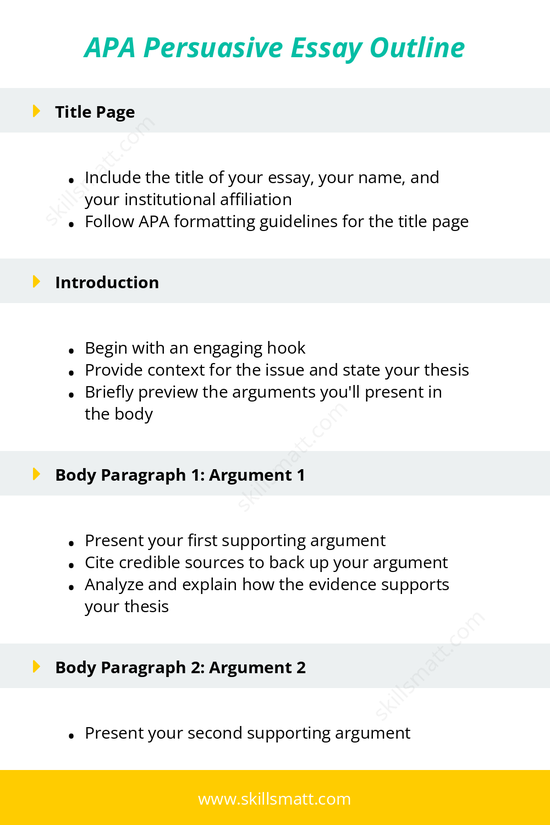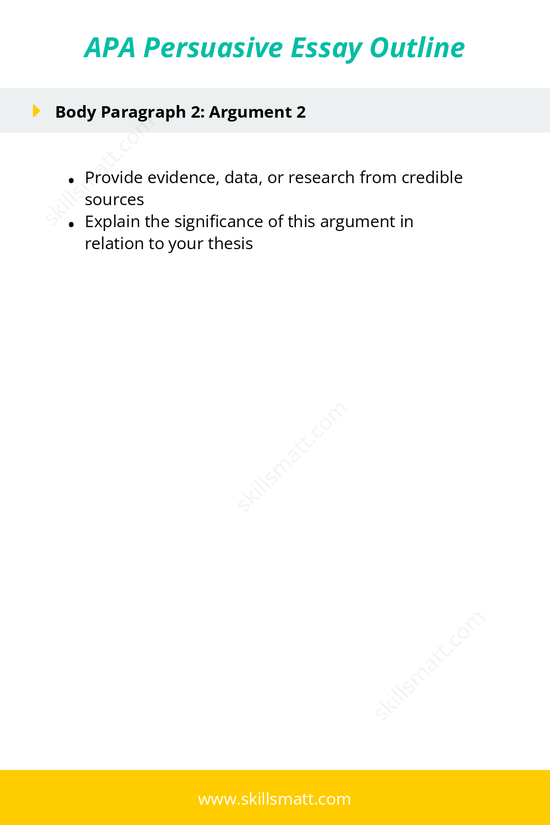APA Persuasive Essay Outline
When writing a persuasive essay using APA formatting, it’s essential to follow a clear structure that allows you to present your arguments logically and persuasively. The APA style emphasizes clarity, organization, and proper citation of sources. Below is a detailed outline for a persuasive essay written in APA format, with a focus on structuring your arguments and providing evidence to support your thesis.
Title Page
The title page is the first page of your APA paper. It should contain key information about your essay, including the title, your name, and institutional affiliation.
- Include the title of your essay, your name, and your institutional affiliation: The title should be concise, clear, and relevant to your topic. Your name and the institution where you are studying should also be included on this page.
- Follow APA formatting guidelines for the title page: Ensure that the title page is formatted according to APA guidelines. This includes specific margins, font size (Times New Roman, 12 pt), and title placement.
Introduction
The introduction is a critical part of your persuasive essay, as it sets the stage for your argument. In this section, you aim to engage your reader, provide context for the issue, and present your thesis statement.
- Begin with an engaging hook: Start your introduction with a hook that captures the reader's attention. This could be a relevant question, an interesting fact, or a striking quote.
- Provide context for the issue and state your thesis: After the hook, provide background information to give your readers a clear understanding of the issue. Follow this by stating your thesis—your main argument or position on the topic.
- Briefly preview the arguments you’ll present in the body: Conclude the introduction by offering a brief preview of the arguments or points you’ll make in the body paragraphs. This gives the reader a roadmap for what to expect.
Body Paragraph 1: Argument 1
The first body paragraph is dedicated to presenting your primary argument in support of your thesis. This is your strongest point, so it should be well-supported with evidence.
- Present your first supporting argument: Introduce your first argument clearly, explaining why it is a critical point in supporting your thesis.
- Cite credible sources to back up your argument: To strengthen your argument, support it with data, research findings, or quotes from credible sources. Remember to cite these sources according to APA guidelines.
- Analyze and explain how the evidence supports your thesis: Don’t just present evidence; explain how it supports your position. Link it back to your thesis to show the relevance of the information you’ve provided.
Body Paragraph 2: Argument 2
The second body paragraph will present your second argument, further reinforcing your position. This argument should build on the first and provide additional evidence or perspectives.
- Present your second supporting argument: Like the first paragraph, introduce your second key point and explain why it is relevant to your thesis.
- Provide evidence, data, or research from credible sources: Support this argument with additional data or research, citing credible sources to back up your claims.
- Explain the significance of this argument in relation to your thesis: Highlight the importance of this argument in reinforcing your thesis. Make sure the reader understands how this point strengthens your overall position.
Body Paragraph 3: Counterargument and Refutation
In this section, you acknowledge a potential counterargument to your position and demonstrate why it is less compelling than your own argument.
- Introduce a counterargument to your position: Present a counterargument that someone who disagrees with your thesis might make. This shows that you have considered other viewpoints.
- Refute the counterargument using logical reasoning and evidence: After introducing the counterargument, provide a rebuttal. Use logical reasoning or empirical evidence to refute the opposing view.
- Reaffirm the strength of your thesis: Conclude this paragraph by reinforcing your position and showing why your thesis remains the stronger argument, despite the opposing viewpoint.
Conclusion
The conclusion wraps up your essay by restating your thesis and summarizing your main arguments. This is your final chance to persuade your reader to agree with your viewpoint.
- Restate your thesis in a fresh way: In the conclusion, restate your thesis, but do so in a way that reflects the evidence and arguments presented in the body of the essay.
- Summarize the main points made in the body paragraphs: Provide a brief summary of the key arguments you made, reminding the reader why your position is valid and well-supported.
- End with a strong concluding thought and a call to action: Finish your essay with a powerful closing statement. You can issue a call to action, urging the reader to take specific steps based on the information you’ve presented, or leave them with a thought-provoking idea that resonates after they finish reading.
By following the APA persuasive essay outline, you ensure that your essay is well-organized, clearly written, and effectively argued. Remember to properly cite all sources according to APA guidelines, as this adds credibility to your argument and helps avoid plagiarism. With a clear structure and solid evidence, your persuasive essay will be impactful and convincing.


